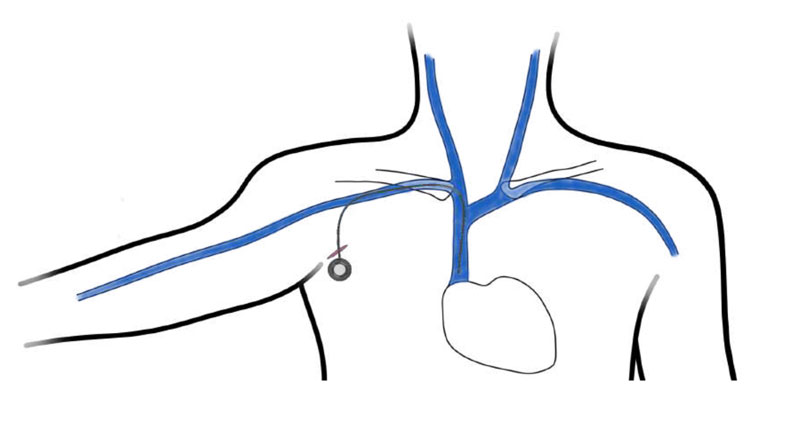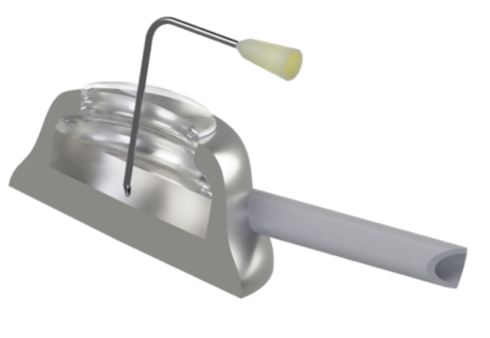Introducing Portacaths: A Fusion of Port and Catheter
True to their name, Portacaths are ingenious devices comprising a port and a catheter. The port, a small injectable chamber, is protected by a robust silicone bung, implanted and secured beneath the skin through a discreet scar.
The catheter, often referred to as a “line,” is a thin, long plastic tube. Imagine one end of this catheter residing in the body’s largest vein, the Superior Vena Cava. This vital vessel carries blood from the head, chest, and arms back into the heart. The other end of the catheter emerges from the vein, seamlessly connecting to the port.

Portacaths come in diverse sizes and shapes, some even equipped with multiple port chambers, enabling the administration of several medications simultaneously. This dynamic design ensures flexibility and effciency in your healthcare management.
Choosing A Portacath: Optimal Convenience For Your Lifestyle
Portacaths stand out as exceptionally durable devices, nestled entirely beneath the skin. This design ensures minimal disruption to your daily activities, including hygiene routines, hobbies, exercise, or social engagements. Portacaths provide a seamless integration into your lifestyle. Choosing a Portacath, as a central venous access device can over several advantages depending on your medical needs. Here are some reasons why you might consider a Portacath:
Convenience: A Portacath provides a convenient and easily accessible central venous access point, reducing the need for repeated needle sticks. This can be particularly beneficial for individuals requiring frequent intravenous treatments, such as chemotherapy or long-term medication administration.
- Reduced Discomfort: Compared to peripheral cannulas, a Portacath can offer reduced discomfort during both insertion and use. Once implanted, the port is located beneath the skin, minimising the impact on daily activities.
Long-Term Use: Portacaths are designed for long-term use, making them suitable for individuals undergoing extended treatment regimens. They can remain in place for months or even years, providing a stable access point for various medical interventions.
Lower Infection Risk: The risk of infection is much lower with a Portacath compared to all other devices as it is implanted beneath the skin, reducing the exposure to external contaminants.
Cosmetic Considerations: The Portacath is placed beneath the skin, resulting in a discreet appearance. This can be a more aesthetically pleasing option for individuals concerned about the visibility of their medical devices.
Flexible Treatment Options: Ports can accommodate various treatments, including chemotherapy, blood transfusions, and the administration of medications. Some ports have multiple lumens, allowing for the simultaneous infusion of different substances.
Improved Quality of Life: The reduced impact on daily activities, combined with the convenience and reliability of central venous access, can contribute to an improved quality of life for individuals requiring ongoing medical treatments.
How Is The Fitting Process Conducted?
The insertion takes place in sterile radiology operating theatres, employing local anaesthesia to ensure complete numbness in the targeted area, rendering the procedure painless. Although mild pressure sensations may be briefly felt, these are of short duration. Sedation is an option for all patients upon request to enhance the overall experience.
Both Ultrasound and X-rays are utilised in tandem to visualise the veins and the device, ensuring precise placement of each catheter at the chosen location. A minor scar of approximately 0.5cm is typical at the point of vein access, either just beneath or above the collarbone, depending on the selected vein. Additionally, there is a small 3cm scar used to insert the port under the skin. All incisions are closed using fully absorbable stitches or glue, eliminating the need for suture removal at a later date.
Typically, the entire procedure lasts between 30-40 minutes, with most patients ready to leave about 60 minutes after completion. If sedation is administered, the recovery period may be slightly extended, and it is imperative that someone drives you home afterward.
Where Is The Portacath Positioned?
Portacaths are typically situated either on the chest, or the inner aspect of the upper arm, although placement can be flexible. Before the fitting procedure, Dr. Simpson will engage in a discussion with you, marking the precise location for the port based on factors such as clothing preferences and undergarments, taking care to avoid interference with straps from bras, backpacks or seatbelts. In pursuit of a more aesthetically pleasing outcome, he often conceals the scar within a natural skin crease located toward the outer chest near the armpit.

How Is The Portacath Used?
The port is accessed using a uniquely shaped ‘Huber’ needle, which penetrates the skin and the ‘self-sealing’ silicone bung on the top of the port, providing entry to the chamber. This chamber connects to the catheter section, allowing blood to be withdrawn from the catheter tip within the vein or facilitating the injection of medications. To enhance comfort, numbing cream can be applied over the skin. Nevertheless, after several accesses, the skin tends to become less sensitive, and many individuals describe the process as painless.

Post-Procedural Care Guidelines:
While portacaths are highly durable, a few measures can be taken to ensure the optimal functioning of the device. For the initial 7 days, it is advisable to limit straining and strenuous activities to promote proper healing of the small scars and minimise bruising. Avoid complete soaking of the area for at least 72 hours, opting for showers by standing to the side and carefully washing around the site. When drying, gently dab with a towel instead of rubbing. While swimming and most sports can be resumed after 14 days, it’s best to avoid contact sports for at least 3 weeks.
The local anaesthetic provides numbness for a few hours post-procedure, and any subsequent mild discomfort or pain can be managed with simple painkillers like Paracetamol and Ibuprofen. Many individuals describe a dull ache at the site, collarbone, or neck area for a few days until the swelling and inflammation subside.
To ensure the continued functionality of the Portacath, a monthly flush with saline is recommended, however if your treatment schedule is more frequent, flushing will coincide with your sessions. When the Portacath is no longer required, removal can be effciently performed under local anaesthesia, and the process is typically faster and easier compared to the initial insertion.
Reassurance Regarding Possible Complications:
While no medical procedure is entirely without risk, Dr. Simpson will thoroughly discuss specific concerns during the consent process. Rest assured, every precaution will be taken to prioritise your safety and minimise any potential delays in your treatment.
It’s important to note that bruising around the site is a common occurrence, especially if you are taking medications to ‘thin’ your blood, but can be minimised by limiting activity in the first 48hrs.
Though there is a small risk of a blood clot forming around the catheter inside the vein, causing occasional swelling in the arm, such occurrences are rare. In this unlikely event, and if the portacath is still functioning, a cautious approach involves starting blood-thinning injections. Removal of the portacath becomes necessary only in the rarest of cases, allowing the clot to be naturally reabsorbed.
While complications such as device failure, infection, or damage to other structures (such as nerves or the lung) are exceedingly rare, it’s essential to emphasize that thorough measures are in place to address and mitigate these possibilities. Your well- being and the success of your treatment remain our utmost priorities throughout this process.
OPENING HOURS
| Monday | 14:00 – 20:00 |
| Tuesday | 18:00 – 20:00 |
| Wednesday | 18:00 – 20:00 |
| Friday | 14:00 – 20:00 |
OFFICE LOCATIONS








